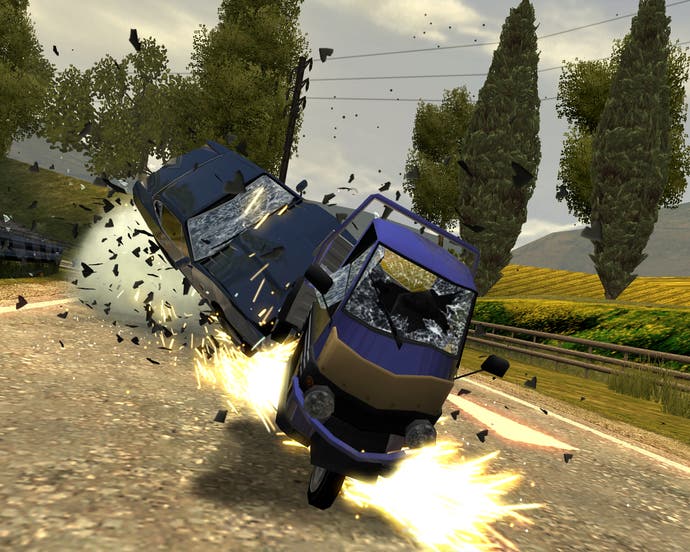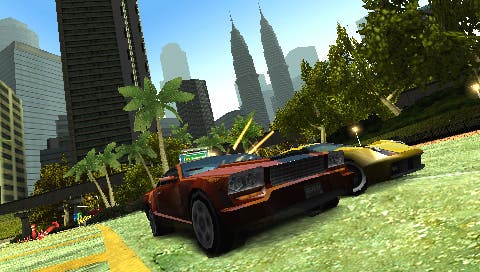Burnout Dominator
The burnout's back.
Once upon a time, Burnout games were about driving fast and close to the edge. They were literally about the burnout: successive speed boosts triggered by following a racing line that steered perilously close to the path of danger for far longer than was sensible. With the third game in the series, the focus shifted away from this knife-edge racing line and towards a brash blend of bumper-car takedowns and slo-mo vehicular violence. It didn't make the games any less enjoyable, but it certainly made them different. Burnout Dominator, however, turns the clock back a little. While it does take some of the design sensibilities from Takedown, it blends them with the return of the burnout to create a game that's not half bad.
The complete removal of the Crash mode will no doubt annoy some people, and it does make Dominator feel a bit stripped down by comparison with the last couple of games. In many respects, though, it affords the game a greater focus. In any case, the dodgem style mentality is still there, since you can still perform takedowns, and you can still apply a bit of aftertouch after crashing to steer yourself into your rivals. But the emphasis here has definitely shifted back to burnout-assisted racing, and the ensuing sense of speed is probably the fastest that the PSP's ever seen.
Combined with the tail-out racing style of something like OutRun, and a comprehensive World Tour mode that breaks the game up into a series of brilliantly entertaining challenges, the result is surprisingly good for something that was presumably conceived of as nothing more than an amuse bouche before the meatier delights of Burnout 5 are dished up later in the year.

The World Tour is divided across seven different classes of vehicle. You unlock each of these in turn by completing successive challenges, and these challenges range from regular races to specific objectives like taking down a certain number of rivals, or racking up points by near-misses (or by drifting, or whatever). These successive challenges are unlocked in some sort of order that presumably has an underlying logic, but if it does, it's obscured to this grandaddy of gaming by a menu system and interface that's clearly geared towards the sugar-heightened, internet-addicted sensibilities of today's teenagers.
That interface is a bit bewildering in the same way as all these games aimed at the youths of today. EA Trax boxouts pop up all over the place to tell you about the latest Avril Lavigne or shouty metal track that's playing in the background (and to obscure any menu choices or information that might be underneath them). There's loads of stuff whizzing round the screen and lots of sudden messages telling you about things you can unlock or what you'll be doing next. You can unlock various achievements over the normal course of the game, which might eventually add up to a trophy, for example. Or you might unlock a preview event. Except I don't fully understand what exactly that means, even though I've managed to unlock about umpteen of them. To judge from my miserably inadequate attempts to ace them, they're probably something to do with unlocking higher-powered cars before you're ready for them.

Which calls my skills as a reviewer into question in several different ways, but there's no question about the quality of the racing underlying all the audio-visual histrionics of the menus. From a technical perspective, Dominator is only adequate, but while the cars are fairly blocky, the sense of speed is unparalleled and the race tracks are uniformly impressive. It's in the handling, and the demands made on your driving skills, that the game excels though - largely because of the return of the burnout. Driving dangerously - dodging in and out of traffic, taking out other racers, drifting round corners - will slowly fill up a meter. If you wait until that meter's completely full, and then use it to trigger a boost of speed, and then continue to drive dangerously while boosting - dodging in and out of traffic, taking out other racers, drifting round corners - you'll be able to continue boosting for as long as you drive dangerously.
It's perfectly pitched between the frustration of failure and the high-speed, adrenaline-fuelled euphoria of success, and it's a welcome return to a more old-school Burnout formula. The only minor gripe is that the game lacks an online multiplayer mode, but it still rises to ad hoc multiplayer, a pass-the-PSP party play mode and downloadable content. And so apart from minor quibbles, it encapsulates exactly what the Burnout series has always been about. Perfectly.
